Estimation of In Situ Heat Capacity and Thermal Diffusivity from Undisturbed Ground Temperature Profile Measured in Ground Heat Exchangers
Abstract
1. Introduction
2. Methodology
2.1. Theoretical Background
2.2. Model Assumptions and Parameter Estimation Procedure
2.2.1. Calculated Undisturbed Ground Temperature Profile
2.2.2. Calculated Damping Depth
2.2.3. Calculated Subsurface Thermal Diffusivity
2.2.4. Calculated Subsurface Volumetric Heat Capacity
2.3. Quality of Parameter Estimation
2.4. Stepwise Procedure for Parameter Assessment
- Accurately measure an equilibrium temperature profile (Tobs (z)) in a BHE and apply proper corrections for the rise of the water level in the U-pipe when using a wired probe as suggested by Pambou et al. [16];
- Perform a standard TRT and evaluate in situ TC;
- Prepare the solver optimization to reproduce the normalized temperature profile (Tg (z)) through Equations (1) to (5);
- Match the observed and calculated temperature profile using Equation (2) and refine the results by minimizing BE (Equation (4)), which describes the difference between TUGT and C1;
- Evaluate the quality of parameter estimation using statistical analysis (Equations (8) and (9)) and proceed to the next step when the results are within the best value range and thus considered acceptable by statical analysis (Equations (8) and (9));
- Calculate the damping depth Zdd, in situ TD and HC (Equations (5)–(7)).
2.5. Validation of the Proposed Method
2.5.1. Borehole Heat Exchanger and Site Description
2.5.2. Field Validation
3. Results
3.1. Estimation of Empirical Parameters
3.1.1. Observed Undisturbed Ground Temperature
3.1.2. Assessment of Empirical Coefficients
3.2. Subsurface Thermal Diffusivity and Volumetric Heat Capacity
3.2.1. Damping Depth (Zdd) and TD Estimation Using the New Empirical Method
3.2.2. HC Estimation Using the New Empirical Method
3.2.3. Comparison of Calculated Subsurface Heat Capacity with the Dual Needle Concept
3.2.4. Comparison of Calculated Subsurface Heat Capacity with OTRT Method
4. Discussion and Conclusions
Author Contributions
Funding
Institutional Review Board Statement
Informed Consent Statement
Data Availability Statement
Acknowledgments
Conflicts of Interest
Abbreviations
| Nomenclature | |
| C1 to C4 | empirical coefficient |
| e | exponential |
| L | length (m) |
| N | number of observations |
| P | harmonic period for a radial frequency |
| SIN | sine function |
| T | temperature (°C) |
| y | assessed parameter |
| z | depth (m) |
| Z | damping depth (m) |
| Greek symbol | |
| α | thermal diffusivity (m2 s−1) |
| λ | thermal conductivity for injection period (W m−1 K−1) |
| π | constant (3.14159265358979) |
| Subscript | |
| calc | calculated |
| dd | damping depth |
| eff | effective |
| g | normalized |
| obs | observed |
| bot | bottom |
| Abbreviation | |
| BHE | borehole heat exchanger |
| Eq | equation |
| HC | volumetric heat capacity |
| OTRT | oscillatory thermal response test |
| RE | relative error |
| RMSE | relative mean square error |
| SC | numerical simulation case |
| TC | thermal conductivity |
| TD | thermal diffusivity |
| TRT | thermal response test |
| 1-U | single U-pipe |
| 2-U | double U-pipe |
| UGT | undisturbed ground temperature |
References
- Gehlin, S.E.A.; Spitler, J.D. Thermal response testing for ground source heat pump systems—An historical review. Renew. Sustain. Energy Rev. 2015, 50, 1125–1137. [Google Scholar]
- Sakata, Y.; Katsura, T.; Serageldin, A.A.; Nagano, K.; Ooe, M. Evaluating Variability of Ground Thermal Conductivity within a Steep Site by History Matching Underground Distributed Temperatures from Thermal Response Tests. Energies 2021, 14, 1872. [Google Scholar] [CrossRef]
- Antelmi, M.; Alberti, L.; Angelotti, A.; Curnis, S.; Zille, A.; Colombo, L. Thermal and hydrogeological aquifers characterization by coupling depth-resolved thermal response test with moving line source analysis. Energy Convers. Manag. 2020, 225, 113400. [Google Scholar] [CrossRef]
- Raymond, J. Assessment of the subsurface thermal conductivity for geothermal applications. Colloquium 2016 Manuscript. Rev. Can. De Géotechnique 2018, 9, 1209–1229. [Google Scholar] [CrossRef]
- Kluitenberg, G.J.; Das, B.S.; Bristow, K.L. Error analysis of the heat pulse method for measuring soil volumetric heat capacity, diffusivity, and conductivity. Soil. Sci. Soc. Am. J. 1995, 59, 719–726. [Google Scholar] [CrossRef]
- Miranda, M.M.; Giordano, N.; Raymond, J.; Pereira, A.J.S.C.; Dezayes, C. Thermophysical properties of surficial rocks: A tool to characterize geothermal resources of remote northern regions. Geotherm. Energy 2020, 8, 4. [Google Scholar] [CrossRef]
- Waples, D.W.; Waples, J.S. A review and evaluation of specific heat capacities of rocks, minerals, and subsurface fluids. Part 1: Minerals and nonporous rocks. Nat. Resour. Res. 2004, 13, 97–122. [Google Scholar] [CrossRef]
- Waples, D.W.; Waples, J.S. A review and evaluation of specific heat capacities of rocks, minerals, and subsurface fluids. Part 2: Fluids and porous rocks. Nat. Resour. Res. 2004, 13, 123–130. [Google Scholar] [CrossRef]
- Márquez, J.M.A.; Bohórquez, M.Á.M.; Melgar, S.G. Ground Thermal Diffusivity Calculation by Direct Soil Temperature Measurement. Application to very low enthalpy geothermal energy systems. Sensors 2016, 16, 306. [Google Scholar] [CrossRef]
- Raymond, J.; Ballard, J.-M.; Pambou, K.C.H. Field assessment of a ground heat exchanger performance with a reduced borehole diameter. In Proceedings of the 70th Canadian Geotechnical Conference and the 12th Joint CGS/IAH-CNC Groundwater Conference, Ottawa, ON, Canada, 4 October 2017. [Google Scholar]
- Giordano, N.; Lamarche, L.; Raymond, J. Evaluation of subsurface heat capacity through oscillatory thermal response tests. Energies 2021, 14, 5791. [Google Scholar] [CrossRef]
- Oberdorfer, P. Heat Transport Phenomena in Shallow Geothermal Boreholes—Development of a Numerical Model and a Novel Extension for the Thermal Response Test Method by Applying Oscillating Excitations. Ph.D. Thesis, Göttingen University, Göttingen, Germany, 2014. [Google Scholar]
- Javidan, M.; Asgari, M.; Gholinia, M.; Nozari, M.; Asgari, A.; Ganji, D.D. Thermal energy storage inside the chamber with a brick wall using the phase change process of paraffinic materials: A numerical simulation. Theor. Appl. Mech. Lett. 2022, 100329, in press. [Google Scholar] [CrossRef]
- Lehr, C.; Sass, I. Thermo-optical parameter acquisition and characterization of geologic properties: A 400-m deep BHE in a karstic alpine marble aquifer. Environ. Earth Sci. 2014, 72, 1403–1419. [Google Scholar] [CrossRef]
- Hakala, P.; Martinkauppi, A.; Martinkauppi, I. Evaluation of the Distributed Thermal Response Test (DTRT): Nupurinkartano as a case study. Rep. Investig. 2014, 211, 35. [Google Scholar]
- Pambou, K.C.H.; Raymond, J.; Lamarche, L. Improving thermal response tests with wireline temperature logs to evaluate ground thermal conductivity profiles and groundwater fluxes. Heat Mass Transf. 2019, 55, 1829–1843. [Google Scholar] [CrossRef]
- Gehlin, S.; and Nordell, B. Determining undisturbed ground temperature for thermal response test. ASHRAE Trans. 2003, 109, 151–156. [Google Scholar]
- Raymond, J.; Lamarche, L.; Malo, M. Extending thermal response test assessments with inverse numerical modeling of temperature profiles measured in ground heat exchangers. Renew. Energy 2016, 99, 614–621. [Google Scholar] [CrossRef]
- Márquez, M.I.V.; Raymond, J.; Blessent, D.; Philippe, M. Terrestrial heat flow evaluation from thermal response tests combined with temperature profiling. Phys. Chem. Earth Parts A/B/C 2019, 113, 22–30. [Google Scholar] [CrossRef]
- Kusuda, T.; Achenbach, P.R. Earth Temperature and Thermal Diffusivity at Selected Stations in United States. ASHRAE Trans. 1965, 71, 61–74. [Google Scholar]
- Horton, R.; Wierenga, P.J.; Nielsen, D.R. Evaluation of methods for determination the apparent thermal diffusivity of soil near the surface. Soil. Sci. Soc. Am. J. 1983, 47, 23–32. [Google Scholar] [CrossRef]
- Taniguchi, M. Evaluation of vertical groundwater fluxes and thermal properties of aquifers based on transient temperature-depth profiles. Water Resour. Res. 1993, 29, 2021–2026. [Google Scholar] [CrossRef]
- Adams, W.M.; Watts, G.; Masson, G. Estimation of thermal diffusivity from field observations of temperature as a function of time and deep. Am. Mineral. 1976, 61, 560–568. [Google Scholar]
- Costello, T.A. Apparent Thermal Diffusivity of Soil Determined by Analysis of Diurnal Temperatures (Fourier Series, Nonlinear Regression). Ph.D. Thesis, Louisiana State University and Agricultural and Mechanical College, Baton Rouge, LA, USA, 1986. [Google Scholar]
- Stallman, R.W. Steady one-dimensional fluid flow in a semi-infinite porous medium with sinusoidal surface temperature. J. Geophys. Res. 1965, 13, 2821–2827. [Google Scholar] [CrossRef]
- Williams, G.P.; Gold, L.W. CBD-180 Ground Temperatures. Natl. Res. Counc. Can. 1976, 100, 101. [Google Scholar]
- Tong, B.; Gao, Z.; Horton, R.; Wang, L. Soil Apparent Thermal Diffusivity Estimated by Conduction and by Conduction–Convection Heat Transfer Models. J. Hydrometeorol. 2017, 18, 109–118. [Google Scholar] [CrossRef][Green Version]
- Xing, L.U. Estimations of Undisturbed Ground Temperatures Using Numerical and Analytical Modeling. Ph.D. Thesis, Oklahoma State University, Stillwater, OK, USA, 1 December 2014. [Google Scholar]
- Nassar, I.N.; Horton, R. Determination of soil apparent thermal diffusivity from multiharmonic temperature analysis for nonuniform soils. Soil. Sci. 1990, 149, 125–130. [Google Scholar] [CrossRef]
- Naranjo-Mendoza, C.; Wright, A.J.; Oyinlola, M.A.; Greenough, R.M. A comparison of analytical and numerical model predictions of shallow soil temperature variation with experimental measurements. Geothermics 2018, 76, 38–49. [Google Scholar] [CrossRef]
- Cui, W.; Liao, Q.; Chang, G.; Chen, G.; Peng, Q.; Jen, T.C. Measurement, and prediction of undisturbed underground temperature distribution. ASME Int. Mech. Eng. Congr. Expo. 2011, 54907, 671–676. [Google Scholar]
- Cho, S.W.; Ihm, P. Development of a Simplified Regression Equation for Predicting Underground Temperature Distributions in Korea. Energies 2018, 11, 2894. [Google Scholar] [CrossRef]
- Márquez, M.I.V.; Raymond, J.; Blessent, D.; Philippe, M.; Simon, N.; Bour, O.; Lamarche, L. Distributed Thermal Response Tests Using a Heating Cable and Fiber Optic Temperature Sensing. Energies 2018, 11, 3059. [Google Scholar] [CrossRef]
- Badache, M.; Eslami-Nejad, P.; Ouzzane, M.; Aidoun, Z. A new modeling approach for improved ground temperature profile determination. Renew. Energy 2016, 85, 436–444. [Google Scholar] [CrossRef]
- IEA ECES ANNEX 21 Thermal Response Test (TRT) Final Report. 2013. Available online: http://media.geoenergicentrum.se/2017/11/IEA_ECES_2013_Annex21_FinalReport.pdf (accessed on 3 August 2015).
- Franco, A.; Conti, P. Clearing a path for ground heat exchange systems: A review on thermal response test (TRT) methods and a geotechnical routine test for estimating soil thermal properties. Energies 2020, 11, 2965. [Google Scholar] [CrossRef]
- Holmes, T.R.H.; Owe, M.; De Jeu, R.A.M.; Kooi, H. Estimating the soil temperature profile from a single depth observation. British Society of Soil Science. Eur. J. Soil Sci. Water Resour. Res. 2008, 44, 9. [Google Scholar]
- Droulia, F.; Lykoudis, S.; Tsiros, I.; Alvertos, N.; Akylas, E.; Garofalakis, I. Ground temperature estimations using simplified analytical and semi-empirical approaches. Sol. Energy 2009, 83, 211–219. [Google Scholar] [CrossRef]
- Adeniyi, M.O.; Oshunsanya, S.O.; Nymphas, E.F. Validation of analytical algorithms for the estimation of soil thermal properties using de Vries model. Am. J. Sci. Ind. Res. 2012, 3, 103–114. [Google Scholar] [CrossRef]
- Gwadera, M.; Larwa, B.; Kupiec, K. Undisturbed ground temperature—Different methods of determination. Sustainability 2017, 9, 2055. [Google Scholar] [CrossRef]
- Wang, J.; Lee, W.F.; Ling, P.P. Estimation of Thermal Diffusivity for Greenhouse Soil Temperature Simulation. Appl. Sci. 2020, 10, 653. [Google Scholar] [CrossRef]
- Eskilson, P. Thermal Analysis of Heat Extraction Boreholes. Ph.D. Thesis, University of Lund, Lund, Sweden, 1987. [Google Scholar]
- Carslaw, H.S.; Jaeger, J.C. Conduction of Heat in Solids; Oxford University Press: Oxford, UK, 1947. [Google Scholar]
- Holzbecher, E. Inversion of temperature time series from near-surface porous sediments. J. Geophys. Eng. 2005, 2, 343–348. [Google Scholar] [CrossRef]
- Lamarche, L.; Raymond, J.; Pambou, K.H.C. Evaluation of the Internal and Borehole Resistances during Thermal Response Tests and Impact on Ground Heat Exchanger Design. Energies 2018, 11, 38. [Google Scholar] [CrossRef]
- Raymond, J.; Bédard, K.; Comeau, F.A.; Gloaguen, E.; Comeau, G.; Millet, E.; Foy, S. A workflow for bedrock thermal conductivity map to help designing geothermal heat pump systems in the St. Lawrence Lowlands, Québec, Canada. Sci. Technol. Built Environ. 2019, 25, 963–979. [Google Scholar] [CrossRef]
- Chouinard, C. Reconstitutions des Températures de Surface au Canada: Des Températures Basales du Glacier Laurentidien Aux Changements Récents du Climat Arctique. Ph.D. Thesis, Université du Québec à Montréal (UQAM), Montreal, QC, Canada, 2008. [Google Scholar]
- Wagner, R.; Clauser, C. Evaluating thermal response tests using parameter estimation for thermal conductivity and thermal capacity. J. Geophys. Eng. 2005, 2, 349–356. [Google Scholar] [CrossRef]
- Radioti, G.; Sartor, K.; Charlier, R.; Dewallef, P.; Nguyen, F. Effect of undisturbed ground temperature on the design of closed-loop geothermal systems: A case study in a semi-urban environment. Appl. Energy 2017, 200, 89–105. [Google Scholar] [CrossRef]
- Dec, D.; Dörner, J.; Horn, R. Effect of soil management on their thermal properties. J. Soil. Sci. Plant Nutr. 2009, 9, 26–39. [Google Scholar] [CrossRef]
- Miranda, M.A.; Marquez, V.M.I.; Raymond, J.; Dezayes, C. A numerical approach to infer terrestrial heat flux from shallow temperature profiles in remote northern regions. Geothermics 2021, 93, 102064. [Google Scholar] [CrossRef]
- Zschocke, A. Correction of non-equilibrated temperature logs and implications for geothermal investigations. J. Geophys. Eng. 2005, 2, 364–371. [Google Scholar] [CrossRef]
- Verdoya, M.; Chiozzi, P.; Pasquale, V. Thermal log analysis for recognition of ground surface temperature change and water movements. Clim. Past 2007, 3, 315–324. [Google Scholar] [CrossRef]
- Antelmi, M.; Alberti, L.; Barbieri, S.; Panday, S. Simulation of thermal perturbation in groundwater caused by Borehole Heat Exchangers using an adapted CLN package of MODFLOW-USG. J. Hydrol. 2021, 596, 126106. [Google Scholar] [CrossRef]
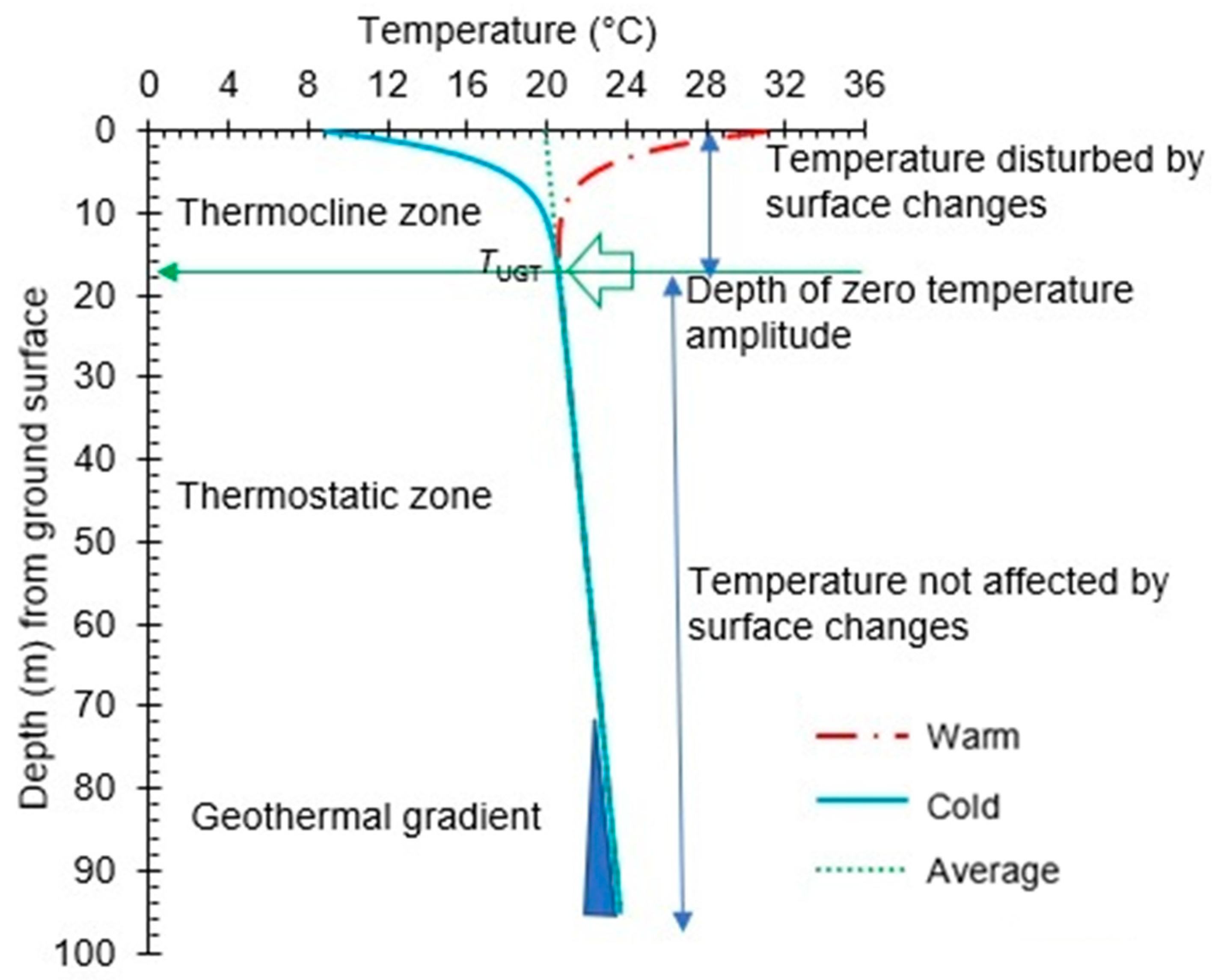
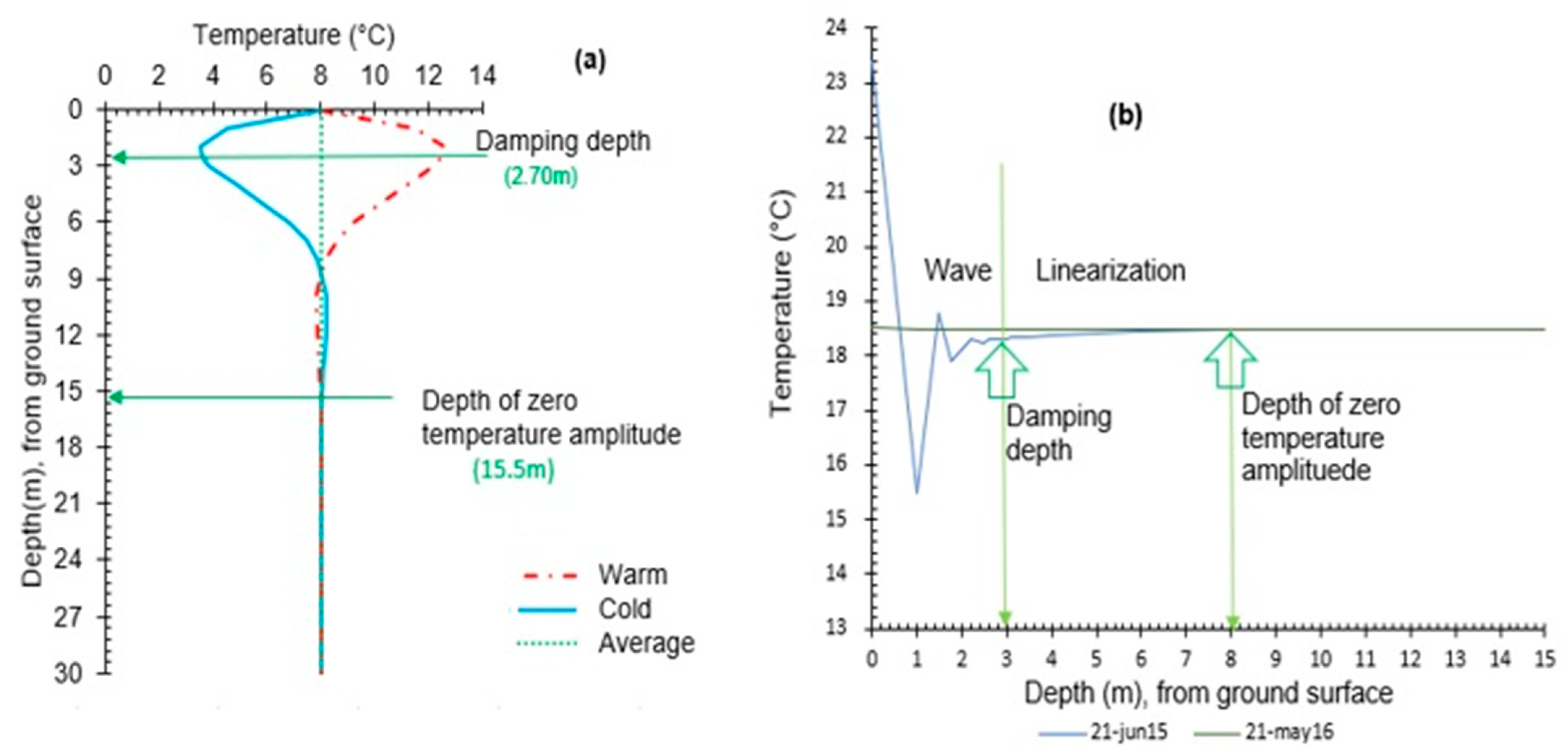
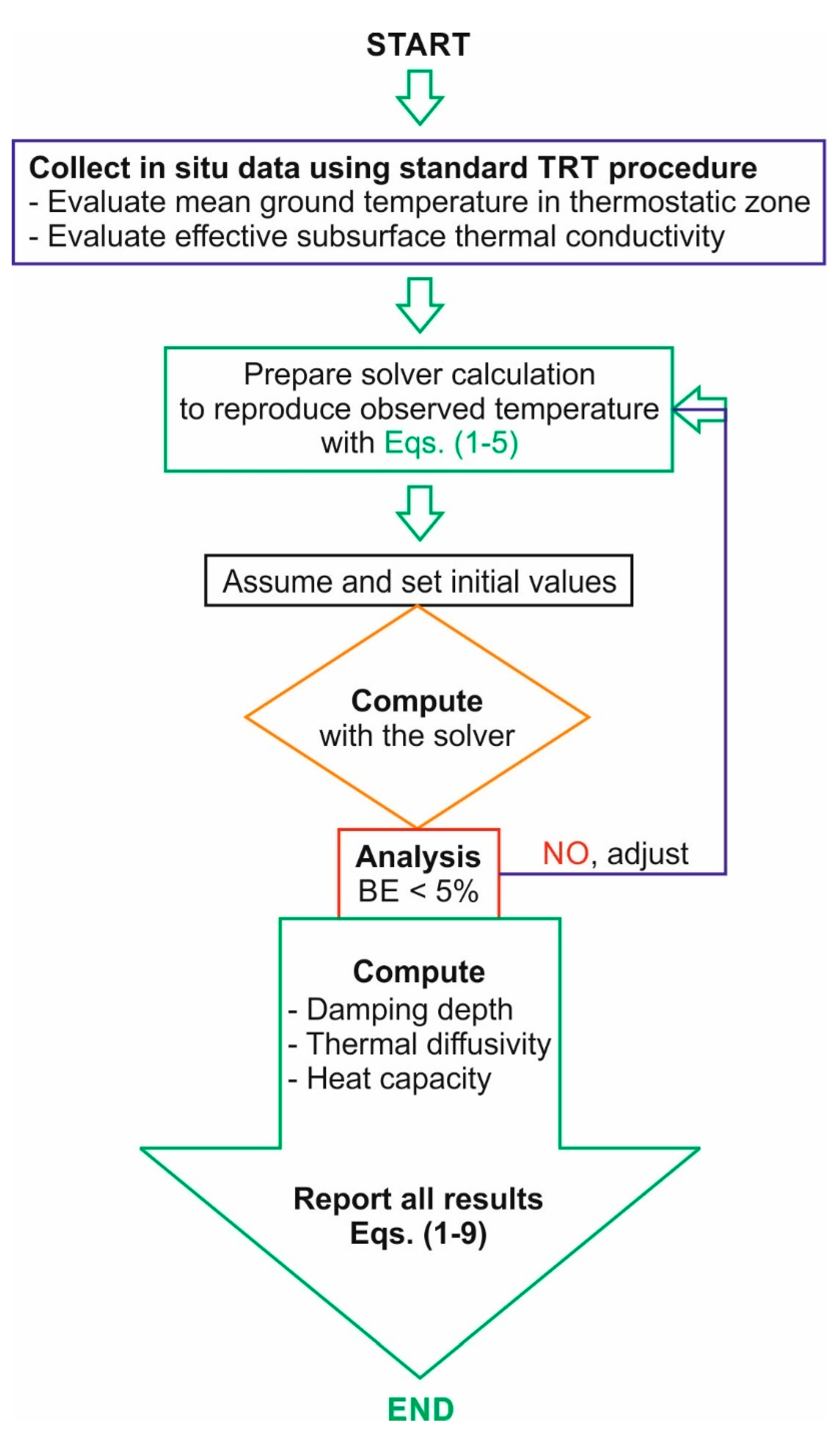
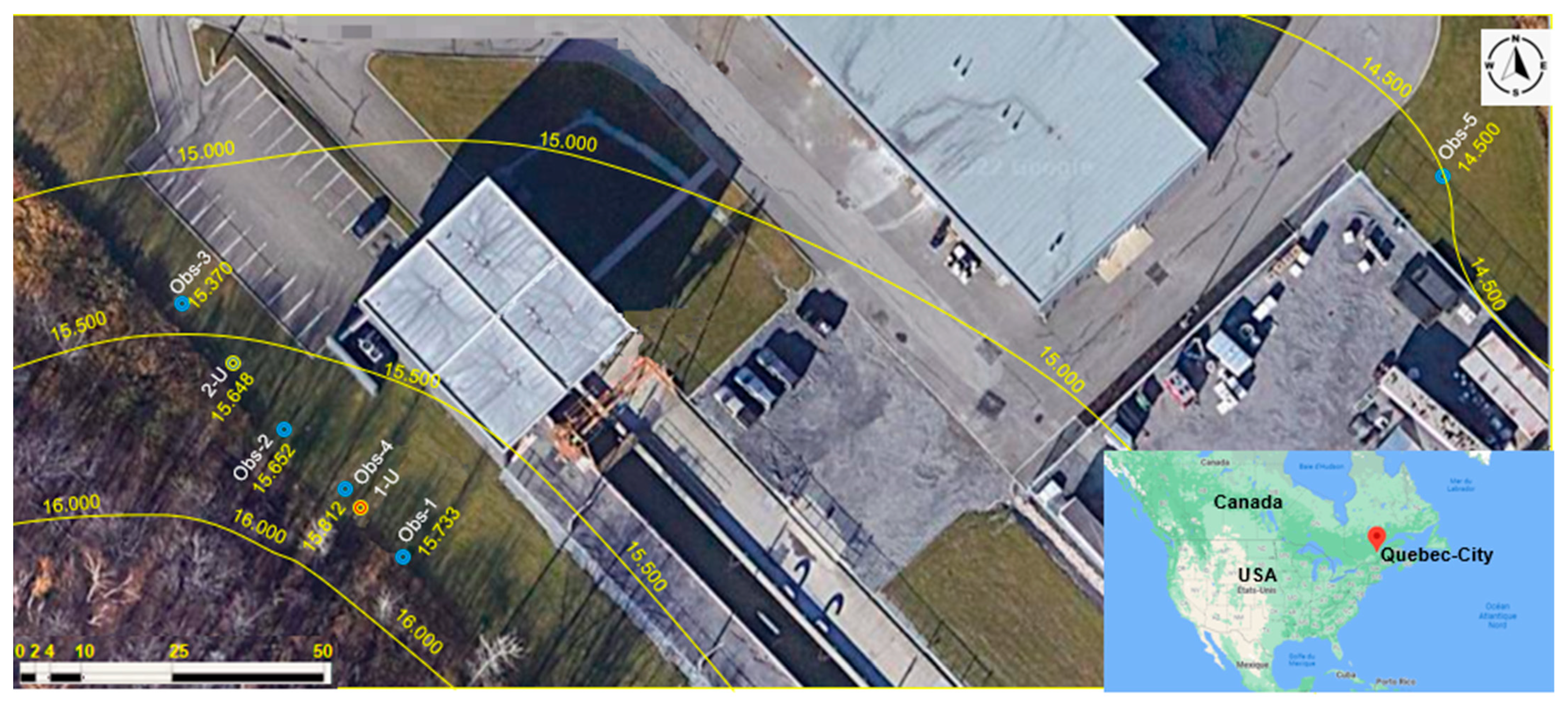

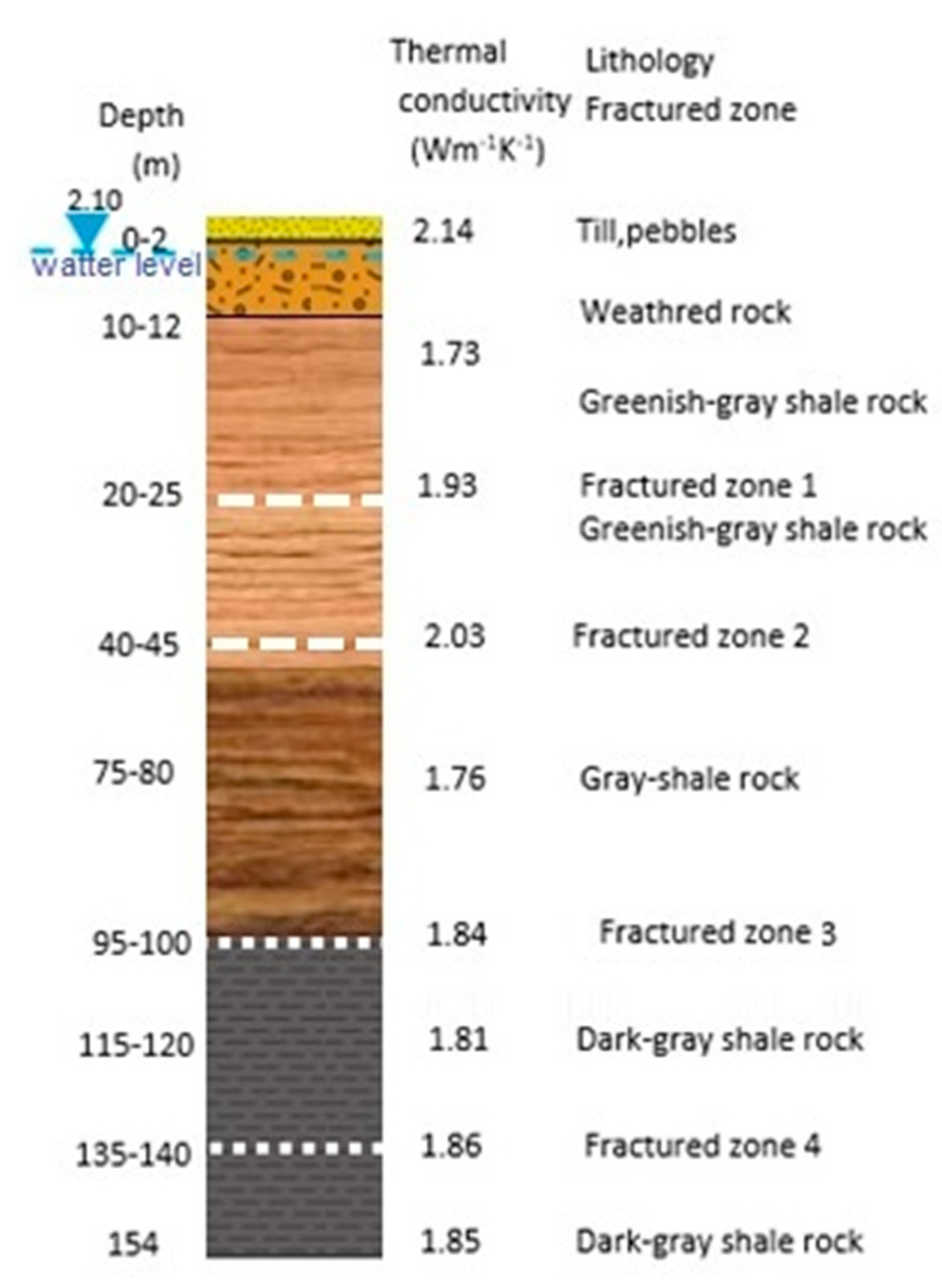
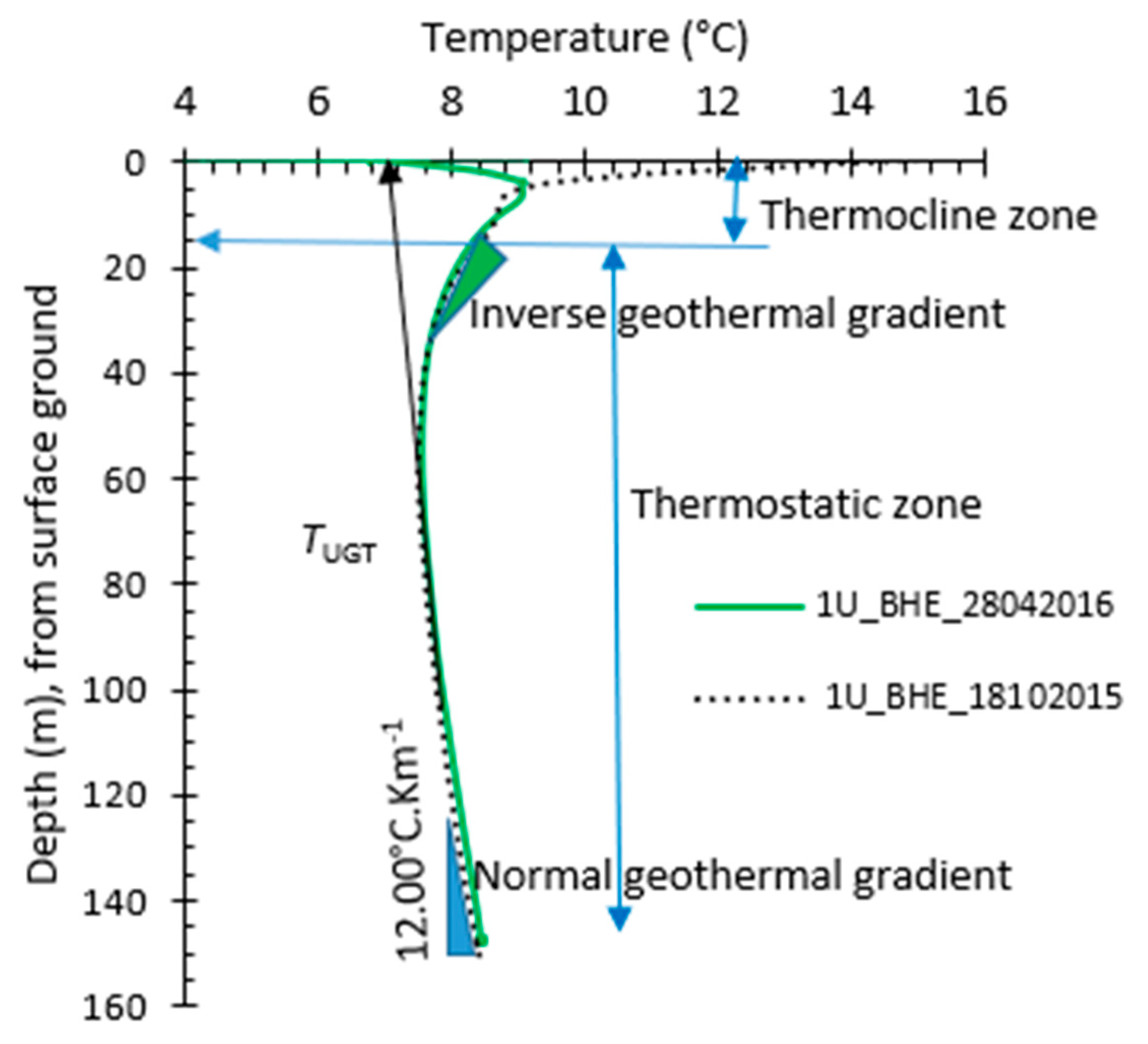
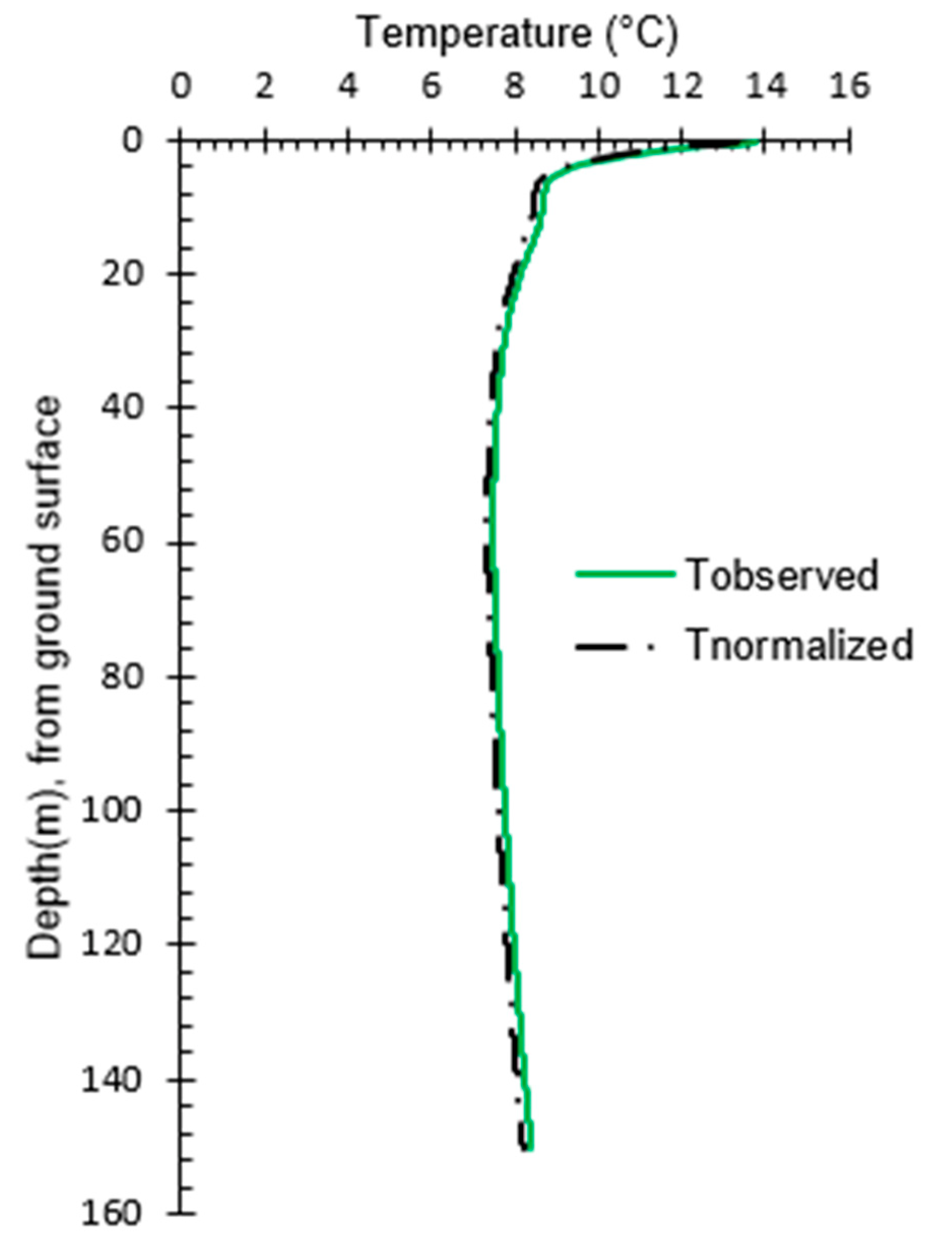
| Empirical Coefficient | Value |
|---|---|
| C1 (°C) | 7.96 |
| C2 (°C) | 0 |
| C3 (m) | 0.30 |
| C4 (m) | 2.52 |
| Parameter | Value | Description |
|---|---|---|
| C1 (°C) | 7.96 | Undisturbed ground temperature |
| Zdd (m) | 2.70 | Damping depth |
| αcalc (m−2 s−1) | 7.28 × 10−7 | Thermal diffusivity |
| HCcalc (MJ m−3 K−1) | 2.40 | Volumetric heat capacity |
| Depth (m) | TRT with Observation Well HC (MJ m−3 K−1) | New Empirical Approach HC (MJ m−3 K−1) | Relative Difference (%) | Thermo-Geological Zone |
|---|---|---|---|---|
| 5 | 2.81 | 2.40 | 14.59 | Overburden (sediments) |
| 7.50 | 2.67 | 10.11 | ||
| 10 | 2.81 | 14.59 | ||
| 12.50 | 2.75 | 12.73 | ||
| 17 | 2.27 | −5.73 | Bedrock (shale) | |
| 22 | 2.48 | 3.23 | ||
| Mean | 2.61 | 2.40 |
| Analysis Procedure | OTRT HC (MJ m−3 K−1) | New Empirical Approach HC (MJ m−3 K−1) | Relative Difference (%) |
|---|---|---|---|
| Thermal recovery period | 2.16 | 2.40 | −11.11 |
| Oscillatory resistance | 1.90 | −26.32 | |
| Phase shift | 3.56 | 32.58 |
Publisher’s Note: MDPI stays neutral with regard to jurisdictional claims in published maps and institutional affiliations. |
© 2022 by the authors. Licensee MDPI, Basel, Switzerland. This article is an open access article distributed under the terms and conditions of the Creative Commons Attribution (CC BY) license (https://creativecommons.org/licenses/by/4.0/).
Share and Cite
Pambou, C.H.K.; Raymond, J.; Miranda, M.M.; Giordano, N. Estimation of In Situ Heat Capacity and Thermal Diffusivity from Undisturbed Ground Temperature Profile Measured in Ground Heat Exchangers. Geosciences 2022, 12, 180. https://doi.org/10.3390/geosciences12050180
Pambou CHK, Raymond J, Miranda MM, Giordano N. Estimation of In Situ Heat Capacity and Thermal Diffusivity from Undisturbed Ground Temperature Profile Measured in Ground Heat Exchangers. Geosciences. 2022; 12(5):180. https://doi.org/10.3390/geosciences12050180
Chicago/Turabian StylePambou, Claude Hugo K., Jasmin Raymond, Mafalda M. Miranda, and Nicolò Giordano. 2022. "Estimation of In Situ Heat Capacity and Thermal Diffusivity from Undisturbed Ground Temperature Profile Measured in Ground Heat Exchangers" Geosciences 12, no. 5: 180. https://doi.org/10.3390/geosciences12050180
APA StylePambou, C. H. K., Raymond, J., Miranda, M. M., & Giordano, N. (2022). Estimation of In Situ Heat Capacity and Thermal Diffusivity from Undisturbed Ground Temperature Profile Measured in Ground Heat Exchangers. Geosciences, 12(5), 180. https://doi.org/10.3390/geosciences12050180







